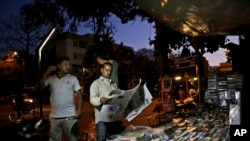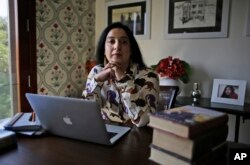A newscast on whether India had become intolerant of dissent quickly spiraled into something darker after a guest on the program referred to a pamphlet that called the Hindu goddess Durga a sex worker. Though the host did not make the remarks, she was accused of disparaging the deity and was bombarded with more than 2,500 threatening calls.
“Some called and said they would douse me with acid,'' Kerala journalist Sindhu Sooryakumar said. Six members of a militant group linked with India's Hindu nationalist ruling party have been arrested.
Sooryakumar is one of a growing number of Indian journalists who say they are increasingly facing a backlash for producing work that raises questions or criticisms of Prime Minister Narendra Modi's government or his Bharatiya Janata Party, or BJP. The crackdowns are happening as journalists try to cover a nationwide debate on how Indian patriotism should be defined – as Hindu or multicultural, devout or secular – and whether dissent should be tolerated.
Members of Modi's government have offered hard-line views on the issue, equating criticism of the government with criticism of the country. Human Resource Development Minister Smriti Irani said last month that “the nation can never tolerate an insult to Mother India,” while Home Minister Rajnath Singh tweeted that anyone shouting anti-India slogans “will not be tolerated or spared.”
Anchor gets death threats
Last week, one of India's best-recognized TV anchors, Barkha Dutt, filed a police report after allegedly receiving “anonymous abusive death threats.” She had been reporting along with others in the capital's media on a university student's arrest for allegedly making anti-India statements. The student criticized the 2013 secret hanging, under a previous government, of a Kashmiri separatist convicted of an attack on Parliament.
Dutt told a conference organized by a women's group that, following her reports, she received calls threatening “rape, sexual abuse and even shooting me.”
During that same student's court hearing on sedition charges last month, lawyers beat reporters and damaged cameras and recording equipment while demanding they not cover public protests against the student's arrest. Journalists from several broadcasters, newspapers and wire services were attacked, including an Associated Press photographer whose hand was bruised and camera lens broken.
The attacks “have heightened concerns about the state of press freedom in India,” said a statement from the international Committee to Protect Journalists.
On Friday, Finance Minister Arun Jaitley issued the first government comments condemning the violence surrounding the hearing, saying ``it was a terrible exception, what happened. Normally people in a public place find media as their natural ally. The whole idea of getting the media dragged into contemporaneous controversy and then attacking it physically is absolutely unacceptable anywhere.''
Journalists have never been entirely safe in India: 11 have been killed since 2010, according to the CPJ. Most were working outside major cities, often covering small-town corruption, when they were killed.
The fact that journalists in major cities such as New Delhi are now being hounded is relatively novel. For years, they operated largely without fear of retribution, thanks in part to the nation's educated, urban elite and the foreign media bearing noisy witness.
“As a journalist, you don't want to be the story yourself,” said Swati Chaturvedi, a veteran print and TV journalist who filed a police report last year while she said she was receiving 300 to 400 threatening messages a day. “I'm actually very scared that, one of these days, this sort of thing will trigger a real riot.”
Moderate space ‘disappearing’
Rahul Jalali, president of the Press Club of India in New Delhi, said he's noticed a creeping change for several years and worries the pressure on journalists could ultimately hurt their credibility.
“The moderate space, even politically, is sort of disappearing, even for journalists. Today, you're being forced to take sides,” Jalali said. “There is a lot of self-censorship going on.''
For the media, “it's disastrous, we're losing our objectivism,” he said. But he hoped it was temporary, noting that India's media had endured previous crackdowns, including Indira Gandhi imposing a state of emergency and seizing powers in 1975-77.
After Sooryakumar, the Kerala news anchor, filed a police complaint about the threatening phone calls she received, police arrested six members of the militant Hindu organization Rashtriya Swayamsevak Sangh, or RSS – the ideological parent of the ruling BJP – for alleged harassment, including posting Sooryakumar's cellphone number to a social media group.
Sooryakumar said the group “exhorted members to call me and solicit my services as a sex worker.”
When the six were released on bail earlier this month, a crowd of RSS members reportedly greeted them with cheers.
Society support
Kerala's BJP president and RSS member Kummanam Rajasekharan denied RSS involvement and said anyone who called the newscaster had “acted so of their own volition.”
The head of Kerala's Union of Working Journalists said the problem was becoming big enough that journalists may need society to help them stand up for free speech.
“The Sindhu Sooryakumar incident is not isolated or a first of its kind,” said C. Rahim. “Earlier, political parties would unequivocally condemn it and initiate action against perpetrators. Now there is an atmosphere of organizational support.”
TV news channel Manorama correspondent Asha Javed said she felt the atmosphere was becoming less safe.
“We have reported about it [intolerance] for some time, and now we are experiencing it first-hand,'' Javed said.
Challenges to coverage
In such a climate, it is becoming more difficult for journalists to cover the country's heated debates about whether people should be allowed to criticize the government, empathize with convicted terrorists, eat beef or make jokes about Hindu gods. Under Indian law, it is illegal to inflame communal tension or stoke violence. Prosecutors are increasingly applying that ban to anything deemed anti-Indian, though they have not targeted journalists.
The apparent increase in harassment, meanwhile, may be a sign of the times. India's enormous population of 1.25 billion is also the world's fastest-growing market for both Internet penetration and smartphone use. Interacting online is something new and exciting for long-isolated populations.
Chaturvedi, the reporter threatened last year, said the environment is one in which “you can't say anything against Modi.”
“These people are inclined to attack if they don't like a story,” she said. “It's a systematic sort of harassment and bullying which will eventually silence a lot of people who don't have the confidence to fight back.”
That's the great fear that Jalali, the press club president, has for his profession.
“In India, the newspaper is read out loud in the village center, and everyone gathers to listen. And most still think what appears in print is gospel,” he said. “But once they realize the news is filled with bias, or even lies, it will affect our democracy. We are the guarantors of free speech. If we don't have free speech, how will we guarantee it for others?”










